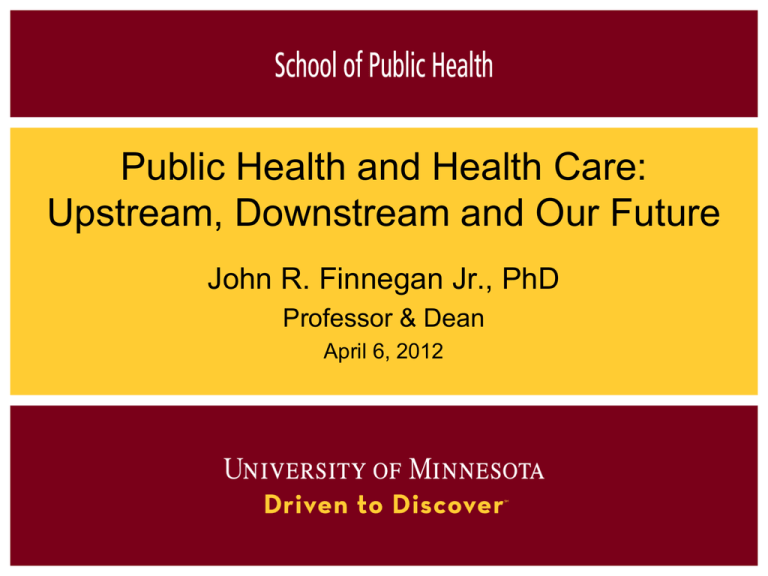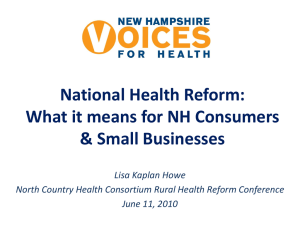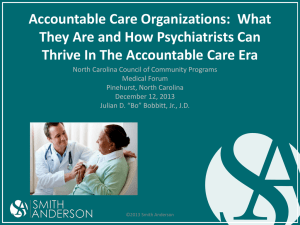Upstream, Downstream and Our Future
advertisement

Public Health and Health Care: Upstream, Downstream and Our Future John R. Finnegan Jr., PhD Professor & Dean April 6, 2012 Disclosures Board member, HealthEast Care System Opinions are my own, not those of HealthEast or the UMN A Wicked Problem for the USA What will it take to enable the USA to make available affordable, quality health care for all of our citizens? Total Health Expenditure Per Capita, U.S. and Selected Countries, 1970, 1980, 1990, 2000, 2008 $8,000 Per Capita Spending - PPP Adjusted $7,000 $6,000 $5,000 $4,000 $3,000 $2,000 $1,000 $- Source: Organisation for Economic Co-operation and Development (2010), "OECD Health Data", OECD Health Statistics (database). doi: 10.1787/data-00350-en (Accessed on 14 February 2011). Notes: Data from Australia and Japan are 2007 data. 2008 figures for Belgium, Canada, Netherlands, Norway and Switzerland, are OECD estimates. 2000 figured for Belgium are OECD estimates. Numbers are PPP adjusted. Break in Series AUS (1998); AUSTRIA(1990); BEL(2003, 2005); CAN(1995); FRA(1995); GER(1992); JAP(1995); NET(1998, 2003); NOR(1999); SPA(1999, 2003); SWE(1993, 2001); SWI(1995); UK (1997. Starting in 1993 Belgium used a different methodology. 1970 1980 1990 2000 2008 Life Expectancy vs. Per Capita Health Spending Expect Less. Pay More. Source: Shah U (2011) Management in Health 15:3. Life Expectancy, Per Capita Spending, Percentage Total Costs Private Sector 2003/2006 Spending for health determinants and health expenditures, 2011 Misalignment!! Government spending on public health Now What? • Paying more, getting less is neither good economics, good politics, nor certainly good health. • Our spending is misaligned with the factors that improve health. • We are wrongly incentivizing patients AND healthcare providers. • The private sector is bearing a major portion of the burden. Now What? • Less than 5% of US health care spending is on public health • The current situation is not sustainable no matter what you think of the Affordable Care Act • How do we approach such a wicked challenge? An important insight about wicked problems “For every complex problem, there is a single solution that is simple, neat, and wrong.” Henry L. Mencken A Wicked Problem for the USA What will it take to enable the USA to make available affordable, quality health care for all of our citizens? Linking Health Care & Public Health Enter The Triple Aim Linking Health Care & Public Health Improve: Population health Care for individuals (Access, Quality) Cost reduction Berwick, Nolan, Whittington (2008). The Triple Aim: Care, Health, and Cost. Health Affairs 27:3, 759-769 Health Reform Era Accountable Care Environment Pay for Performance Fee for Value Continuum from: Patient outcomes to Physician Performance to Reimbursement To Achieve Triple Aim Enrollment of an identified population Commitment to universality for its members An organization (an “integrator”) that accepts responsibility for all three aims for that population. Berwick, Nolan, Whittington (2008). The Triple Aim: Care, Health, and Cost. Health Affairs 27:3, 759-769 Roles of the “Integrator” Partnership with individuals and families Redesign of primary care Population health management Financial management, and macro system integration. Berwick, Nolan, Whittington (2008). The Triple Aim: Care, Health, and Cost. Health Affairs 27:3, 759-769 Roles of the “Integrator” Partnership with individuals and families Education, communication re: health status Shared decision-making, management Change “more-is-better” culture Berwick, Nolan, Whittington (2008). The Triple Aim: Care, Health, and Cost. Health Affairs 27:3, 759-769 Roles of the “Integrator” Redesign of primary care Expanded role primary care team Physicians not necessarily sole or main care provider Long-term relations, plans of care, coordination, navigation, infrastructure and capacity Berwick, Nolan, Whittington (2008). The Triple Aim: Care, Health, and Cost. Health Affairs 27:3, 759-769 Roles of the “Integrator” Population health management Anticipating, shaping patterns of care for important subgroups Prevention with a focus on behavior and other health determinants Chronic disease management (e.g., Congestive Heart Failure) Berwick, Nolan, Whittington (2008). The Triple Aim: Care, Health, and Cost. Health Affairs 27:3, 759-769 Roles of the “Integrator” Financial management and macro system integration Defining, measuring, making transparent per capita cost of care to beneficiaries Reducing waste in care areas Value added by producing the best health outcome(s) at lowest cost over longest period of time Berwick, Nolan, Whittington (2008). The Triple Aim: Care, Health, and Cost. Health Affairs 27:3, 759-769 Approaches to the Triple Aim Technology: EHR, HIE and computerized provider order entry population analytics clinical transformation care management solutions Cozzens, T (2012 Jan 10) Hospital and Health Networks Daily A Wicked Problem for the USA Does public health have anything to offer? If so, what? Any track record? Upstream-Downstream Chronic Care> Acute Care> <Preventive Med Upstream: • • • • Populations Systems Environment Methods Upstream-Downstream Public Health> Methods: <Preventive Med Chronic Care> • Scientific Acute Care> Biostatistics Epidemiology Env. Health Social & Behavioral Sciences Policy & Economic sciences Upstream-Downstream Public Health> Methods: <Preventive Med Chronic Care> • Intervention Acute Care> Education Technology Policy Impact of Public Health Since 1900, the average life expectancy for Americans has increased by about 30 years. Public health initiatives account for about 25 of those additional years. *Turnock, BJ. Public Health: What it is and How it Works, 3rd Edition. Sudbury, MA: Jones and Bartlett Publishers, 2004. Top 10 Public Health Achievements Increased average lifespan 1900: 49 years 1999: 75 years Sanitation and water Vaccination Control of Infectious Disease Safer Workplaces Top 10 Public Health Achievements Healthier mothers and babies Family planning Safer food Heart disease and stroke prevention Smoking Public health improvements = 20 years added to lifespan Medical improvements = 5 years added to lifespan Minnesota’s Response: Health Reform Act 2008 Redesign primary care: Health Care Homes Population Health: SHIP (Weight, Smoking) Quality & Cost Payment Reform Supporting: Health Care Reform Review Council, E-Health Affordable Care Act 2010 • New insurance marketplace Expanded access to coverage State-based exchanges • Insurance market reform • Changes to Medicare; expansion Medicaid; close Part D “donut hole” by 2020 • Prevention, public health & wellness programs, IT, waste & fraud reduction Affordable Care Act 2010 • Redesign Primary Care • Accountable Care Organizations (ACO’s) • Integrated systems • Team-based care • Cost control • CQI the patient experience • Outcomes driven • Pay for value, performance Will ACO’s Work? Skeptics: “…ACO’s just new name for HMO network formation of the 90’s; now physician hospital organizations and group practices without walls…large, locally dominant provider systems will just get bigger and run up prices…” Allan Baumgarten, Health Market Reviews & Consulting, (Association of Health Care Journalists listserv 4-5-12) Will ACO’s Work? Skeptics: “…physician groups receive performance payments tied to shared savings and to achieving certain quality and cost targets for [their] Medicare beneficiaries…Physician Group Practice R&D Project funded by CMS showed mixed results…N Engl J Med 2011; 365:1659-1661 Allan Baumgarten, Health Market Reviews & Consulting, (Association of Health Care Journalists listserv 4-5-12) Affordable Care Act 2010 Established: The National Prevention, Health Promotion, and Public Health Council (Ch. Surgeon General; 17 agencies) “…provides coordination, leadership at the federal level and among all executive agencies regarding prevention, wellness, and health promotion practices…” Affordable Care Act 2010 Established April 2011: Advisory Group on Prevention, Health Promotion, and Integrative and Public Health (non-federal, no more than 25 members) develop policy and program recommendations advise the National Prevention Council on lifestylebased chronic disease prevention and management, integrative health care practices, and health promotion. Affordable Care Act 2010 Established: Prevention & Public Health Fund “…expanded and sustained national investment…in public health” Advance effectiveness of communitybased prevention FY13 amount: $1.25 billion National Prevention Strategy America’s Plan for Better Health and Wellness Broad Strategic Directions • Build Healthy and Safe Community Environments • Expand Quality Preventive Services in Clinical and Community Settings • Empower People to Make Healthy Choices • Eliminate Health Disparities National Prevention Strategy America’s Plan for Better Health and Wellness Priority Areas Tobacco-free living Prevent drug abuse and excessive alcohol use Healthy eating Active living Injury and violence-free living Reproductive and sexual health Mental and emotional wellbeing So what keeps medicine and public health from closer work? • Prevention and Public Health Fund of the ACA labeled “slush fund” by the right • Culture: Public health “too government;” Medicine “too private sector” to effectively identify common goals • Austerity alone won’t cut it • Any joint process to aim at common goals? Stine & Chokshi (2012) NEJM Community Health Improvement Process IOM (2012) Improving health in the community: a role for performance monitoring. Social Ecology Model Theory Change assumptions Causal paths Applications Interventions Measures Organizations Family Interpersonal Individual Questions about change How do public health applications differ through each “lens”: psychosocial, community, economic, policy? What does “change” look like with respect to the level of the individual and the collective? If we had to make a hard choice about strategies we think will be more effective, what would we choose? The Prevention Paradox “A prevention measure that brings large benefits to the community affords little to each participating individual” Geoffrey Rose How much change? • An additional mean intake of 1/2 serving of fruits and vegetables in the population would reduce cancer incidence by 7% • For every pound of extra weight, the risk of Type 2 diabetes increases by 4% • A reduction in serum cholesterol of 1% results in a 2% reduction of CVD risk Challenges of promoting population health Adequate and steady funding Provides for future rather than immediate benefit Solutions multi-factorial, multi-sectoral Challenges entrenched commercial interests Fragmentation of public health Bovbjerg, Ormond, Waidmann (2011 Nov) What directions for public health under The Affordable Care Act? Urban Institute Health Policy Center. www.urgan.org So what are the opportunities? • IRS Community Benefit requirements ACA To qualify, non-profit hospitals must do Community Health Needs Assessments (CHNA) Identify metrics for outcomes Public health: informatics, data mining, outcomes and effectiveness analysis Stine & Chokshi (2012) NEJM So what are the opportunities? • ACO status – Accountable Care Organizations – implementing the Triple Aim Track health outcomes Track per capita costs Active intervention, management of populations Stine & Chokshi (2012) NEJM Minnesota How well are we doing to achieve the Triple Aim? What are we doing right? What do we need to improve? Triple Aim: 1) Population Health; 2) Affordability, Quality of Outcomes, Patient Experience; 3) Cost Reduction Minnesota 1) Population Health 2) Affordability, Quality of Outcomes, Patient Experience 3) Cost Reduction Grade: A-F Minnesota Identify and discuss three priorities for bringing public health agencies and health care organizations closer in alignment with the goal of population health improvement. How about obligations of other organizations, institutions? Public Opinion, ACA Ten Essential Public Health Services • Monitor health status to identify community health problems. • Diagnose and investigate health problems and health hazards in the community. • Inform, educate, and empower people about health issues. • Mobilize community partnerships to identify and solve health problems. • Develop policies and plans that support individual and community health efforts. Ten Essential Public Health Services • Enforce laws and regulations that protect health and ensure safety. • Link people to needed personal health services and assure the provision of health care when otherwise unavailable. • Assure a competent public health and personal healthcare workforce. • Evaluate effectiveness, accessibility, and quality of personal and population-based health services. • Research for new insights and innovative solutions.








